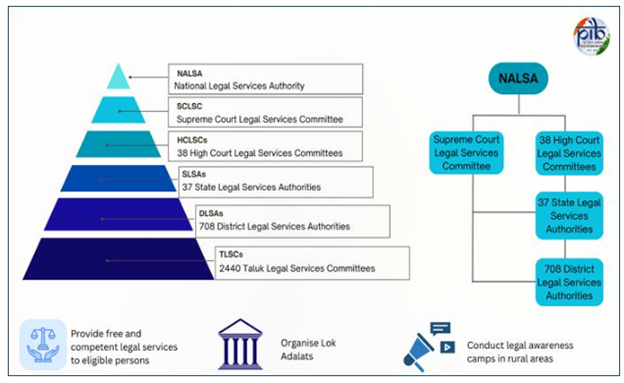India’s Legal Aid and Awareness Initiatives
Introduction:
Every year on 9 November, India observes National Legal Services Day. This day commemorates the coming into force of the Legal Services Authorities Act, 1987. The Act created a framework of legal services authorities across the country to ensure that marginalised and disadvantaged people can access free legal aid.
Rationale:
-
- Article 39A (DPSP): Directs the State to provide free legal aid to ensure that justice is not denied due to economic or social disability.
- Part IV – DPSPs emphasise social justice and human dignity.
- The Act operationalises Article 39A and makes access to justice a statutory right, not charity.
Legal Services Authorities Structure:
The Legal Services Authorities Act, 1987 set up:
1. National Legal Services Authority (NALSA) headed by the Chief Justice of India.
2. State Legal Services Authorities headed by the Chief Justice of each High Court.
3. District Legal Services Authorities headed by the District Judge.
This layered structure ensures local access and oversight. The Act also creates forums such as Lok Adalats, Permanent Lok Adalats to deal with pending cases and pre-litigation disputes amicably. From 2022-23 to 2024-25, more than 23.58 crore cases were resolved via these forums.

Key Takeaways from PIB
-
- National Legal Services Day marks implementation of the Legal Services Authorities Act, 1987.
- 44.22 lakh beneficiaries received free legal aid (2022–25).
- 23.58 crore cases resolved through Lok Adalats (2022-25).
- 2.10 crore people received services under DISHA (pre-litigation advice + pro bono support).
Legal Services Authorities Funding Mechanism:
Legal aid is funded by the central and state governments and donations through a three-tier funding structure:
-
- Central funding or donations to the Central Authority through the National Legal Aid Fund
- Central or State Government funding or other contributions to the State Authority through the State Legal Aid Fund
- State Government funding or other donations to the District Authority through the District Legal Aid Fund
Key Initiatives & Schemes-
Legal Aid Defence Counsel System (LADCS)
-
- Under this scheme by NALSA, free legal defence is provided in criminal cases for eligible persons under the Act.
- As of 30 September 2025, 668 districts have a functional LADCS office.
- From 2023-24 to 2025-26 (till Sept 2025), over 7.86 lakh cases out of 11.46 lakh assigned were disposed.
- Approved financial outlay from 2023-24 to 2025-26: ₹998.43 crore.
DISHA (Designing Innovative Solutions for Holistic Access to Justice)
-
- Launched in 2021 (for 2021-26) with an outlay of ₹250 crore.
- By 28 February 2025, around 2.10 crore people received pre-litigation advice, pro-bono services and awareness.
- Includes tele-law, online legal aid portals and outreach efforts.
Legal Awareness Programmes & Training
-
- From 2022-23 to 2024-25 approximately 13.83 lakh awareness programmes conducted & approximately 14.97 crore persons attended them.
- Training for para-legal volunteers (PLVs) & legal services lawyers.
- Over 56 legal awareness TV programmes in six languages reached over 70.70 lakh people.
- LLLAP (Legal Literacy & Legal Awareness Programme) developed materials in 22 scheduled languages/dialects for Northeastern states.
Fast-Track Courts (FTCs)
-
- Created for speedy trial of heinous crimes, civil cases of women, children, senior citizens, disabled persons and older property cases. As of 30 June 2025: 865 FTCs functional.
Fast Track Special Courts (FTSCs)
-
- Under 2019 scheme, dedicated to victims of serious sexual offences including POCSO. As of June 2025: 725 FTSCs (including 392 POCSO courts in 29 States/UTs) & disposed 3,34,213 cases since inception.
Gram Nyayalayas
-
- Rural grassroots courts. As of March 2025: 488 Gram Nyayalayas.
Nari Adalats
-
- Under the Mission Shakti scheme of the Ministry of Women & Child Development. Pilot implementation in various Gram Panchayats across states and UTs; help women get legal aid, empowerment and mediation for domestic/gender violence.
How a Person Gets Aid
1. A person who is economically or socially disadvantaged applies for legal aid (in writing, orally, or online).
2. The Legal Services Institution reviews the application and makes a decision within 7 days.
3. If eligible, the applicant is assigned a lawyer; the applicant is informed of the lawyer and their contact details.
4. The person receives legal advice or representation, or access to alternative dispute resolution (Lok Adalat).
5. Awareness programmes and tele-law, paralegal volunteers support outreach.
6. For criminal cases, LADCS scheme ensures free defence.
7. For dispute resolution (civil or pre-litigation), Lok Adalats, Permanent Lok Adalats, Gram Nyayalayas help provide faster settlement.
Challenges of Legal Services Authorities:
Based on recent reports and research, the legal aid and justice delivery system face several structural and operational challenges:
1. According to an article in The Indian Express, the workload per judge in India has risen (from 2,391 in 2022 to 2,474 in 2024) while pending cases run into crores which undermines the right to timely justice.
2. The New Indian Express reports “hesitation among legal professionals” in adopting legal-tech tools, while access remains uneven in rural/remote areas.
3. It was also highlighted that women lawyers still face systemic hurdles in gaining trust and opportunities equal to men. Also, marginalised caste groups may have less access to legal services.
4. One research report points out inadequate funding, uneven coverage, and sometimes lack of professional legal aid quality.
5. According to PRS, badly drafted laws and poor policy-implementation reduce the efficacy of legal interventions.
Recommendations:
Drawing on insights from legal-policy research and media articles, here are a few key recommendations:
-
- Increase funding & state top-ups for legal aid to ensure pensions, services and programmes are adequately resourced and uniform across States.
- Expand digital infrastructure and connectivity for tele-law and online applications, especially in remote/rural areas, ensuring no one is left behind by the digital divide.
- Promote gender and social inclusion in the legal profession and legal aid services: ensure more women, SC/ST/OBC persons are trained as paralegal volunteers, panel lawyers, etc.
- Strengthen monitoring, data collection and transparency: public dashboards, outcome tracking of cases resolved, quality measures of legal aid services.
- Enhance legal awareness programmes with local-language materials, community outreach in marginalised areas, and embed legal literacy in school/college curricula.
- Encourage alternative dispute resolution expansion (Lok Adalats, Gram Nyayalayas) with enhanced outreach to reduce burdens on regular courts and ensure faster justice.
Conclusion:
The National Legal Services Day initiative and associated legal aid frameworks are pivotal for ensuring justice for all. With strengthened funding, technology, inclusion and outreach, India’s legal aid system can live up to its constitutional promise.
Spread the Word
